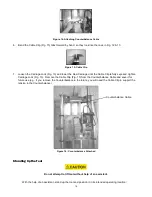
8
c.
SECURE WORK PROPERLY. If a piece is supported on both sides of the cut in such a way that it allows
the material to bow and pinch the blade, it may produce kickback. Do not cut pieces smaller than the
saw carriage. Support large panels properly.
d.
IF THE BLADE BINDS, TURN SAW OFF! The saw or work piece may kick back. Keep hands, body,
and bystanders out of the path of the blade and material.
e.
STAY ALERT. Watch what you are doing and use common sense. Do not allow yourself to be
distracted. Do not operate the tool when you are tired or under the influence of drugs or alcohol. Hold
the tool and material firmly and exercise control at all times. Position yourself and co-workers out of the
kickback path. Repetitive cuts that lull you into careless movements can also cause kickback. A brief
“stretch” may be all that is necessary to avoid a problem.
f.
RESTARTING IN MID-CUT. If the saw is stopped in mid-cut, TURN SAW OFF! Allow the blade to
stop. Then back up the saw (if crosscutting) or the board (if rip cutting) before restarting.
g.
IF THE BLADE STALLS, TURN SAW OFF! DO NOT TURN THE SWITCH ON AND OFF. A dull blade
or excess pressure may cause stalling. TURN OFF the switch immediately if the blade binds or the saw
stalls, and remove the saw from the cut.
h.
AVOID CUTTING NAILS OR OTHER FASTENERS. Inspect for and remove all metal fasteners before
cutting.
i.
SUPPORT THIN MATERIAL. Large sheets such as paneling, Formica, etc., tend to warp or sag and
must be well supported over their entire length to avoid pinching the blade. Optional hold down bar
recommended for this application.
27.
HANDLE THE COUNTERBALANCE WITH CARE. The counterbalance cable is under tension. See page 16.
Always attach the cable to the saw carriage before removing the cable clip. Do not pull on the cable by hand
or attempt to disassemble or repair the counterbalance. Replacement counterbalances can be purchased
directly from Safety Speed, or an authorized dealer.
28.
DO NOT USE PUSH STICKS.
29.
CROSSCUTTING (VERTICAL CUTTING) MUST ALWAYS BE DONE FROM THE TOP DOWN. Raise the saw
carriage to the uppermost position on the guides and lock it into position with the carriage lock whenever the
tool is not in use. See “Operating Procedure: Crosscutting”, for more information.
30.
RIPPING (HORIZONTAL CUTTING) MUST ALWAYS BE DONE WITH THE DIRECTION OF THE ARROW.
Raise the saw carriage to the top of the guides and lock it into position with the carriage lock whenever the tool
is not in use. See “Operating Procedure: Rip cutting”, for more information.
31.
ALWAYS WAIT FOR THE BLADE TO STOP COMPLETELY BEFORE CHANGING POSITIONS. Unplug the
tool before transporting or moving it.









































